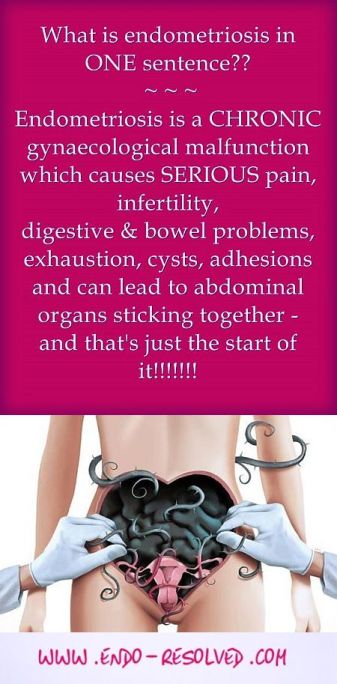Endometriosis

Mayo Clinic's definition on their website:
Endometriosis (en-doe-me-tree-O-sis) is an often painful disorder in which tissue that normally lines the inside of your uterus — the endometrium — grows outside your uterus. Endometriosis most commonly involves your ovaries, fallopian tubes and the tissue lining your pelvis. Rarely, endometrial tissue may spread beyond pelvic organs.
With Endometriosis, displaced endometrial tissue continues to act as it normally would — it thickens, breaks down and bleeds with each menstrual cycle. Because this displaced tissue has no way to exit your body, it becomes trapped. When Endometriosis involves the ovaries, cysts called endometriomas may form. Surrounding tissue can become irritated, eventually developing scar tissue and adhesions — abnormal bands of fibrous tissue that can cause pelvic tissues and organs to stick to each other.
Endometriosis can cause pain — sometimes severe — especially during your period. Fertility problems also may develop.
source
Endometriosis Association's definition on their website:
Endometriosis is a puzzling disease that affects our hormones, our immune system (the system that fights germs and cancer), and the digestive tract(the system involved in the breakdown and absorption of our food).
The name comes from the word “endometrium” which is the tissue that lines the inside of the uterus. Each month, or cycle, this tissue builds up and sheds, causing the normal bleeding experienced during the period. With Endometriosis, tissue like this is found outside of the uterus in other areas of the body, such as the abdomen, intestines, bladder, and other places. In these other locations, the tissue develops into what are called “growths” or “implants.”
Like the lining of the uterus, endo growths usually respond to the hormones of the menstrual cycle. They can build up tissue and shed each cycle causing bleeding.
The result of this bleeding and the immune problems that are part of endo are the formation of scar tissue, pain, and other complications.
source

Common Symptoms
- Pelvic Pain- can vary (some relate it to labor pains or more severe)
- Infertility
- Estrogen Dominance
- Chronically heavy or long periods
- Migraines
- Crippling menstrual pain
- Painful intercourse
- Increased pain during bowel movements
- Increased pain during urination
- Spotting and bleeding between cycles
- Painful digestion
- Constipation
- Nausea
- Chronic lower back pain
- Joint pain
- Nerve pain
- Chronic fatigue
- Bloating
sources
Stages 1-4
A staging, or classification, system for endometriosis has been developed by the American Society of Reproductive Medicine. The stages are classified as follows:
-
Stage 1: Minimal
-
Stage 2: Mild
-
Stage 3: Moderate
-
Stage 4: Severe
The stage of endometriosis is based on the location, amount, depth and size of the endometrial tissue. Specific criteria include:
-
The extent of the spread of the tissue
-
The involvement of pelvic structures in the disease
-
The extent of pelvic adhesions
-
The blockage of the fallopian tubes
The stage of the endometriosis does not necessarily reflect the level of pain experienced, risk of infertility or symptoms present. For example, it is possible for a woman in stage 1 to be in tremendous pain, while a woman in stage 4 may be asymptomatic.
source
Statistics
- 1-10 women get effected by endometriosis during their reproductive years (ages of 15-49)
- 176 million women in the world have Endometriosis
- 73% have had their relationships affected by Endometriosis
- 10 years is the average time it takes for a woman to be diagnosed with Endometriosis
- 27 is the average age when a woman is first diagnosed with Endometriosis
- 68% of woman with Endometriosis were initially misdiagnosed with another condition
- 30-50% of women with Endometriosis may experience infertility
- 82% of women are at times unable to carry out day to day activities due to Endometriosis
- 40% -Patients in whom it can persist beyond menopause following hysterectomy
source

The above shows one theory on how it can form.

The above shows places it can attach to. As stated above in stages- it can at severe stages, fuse organs together.
Ways to Diagnose
Laparoscopy
This is the best way to diagnose and in most cases to treat the Endometriosis. Laparoscopy is an outpatient procedure in which a small incision is made under the belly button (umbilicus). CO2 gas is inserted into the abdomen to help separate the organs. A small telescope is inserted to view the female reproductive organs, intestines and pelvic wall. The surgeon is then able to see the tissue implants which may have attached themselves to the ovaries, fallopian tubes, uterine walls, rectum, bladder and/or pelvic wall.
source
Exam and Ultrasound
Many skilled surgeons and doctors that specialize in Endometriosis can diagnose with their findings from an internal exam and or ultrasound. This is why it is truly important to find a specialist that has made this disease their focus. Many doctors and obgyns can diagnose through laparoscopy mentioned above; however, they may not be trained or skilled enough to work on the disease as a specialist can. Also, a laparoscopy may be unnecessary if you go to a true specialist that may be able to diagnose another way.
Exercise
It may seem counterproductive to exercise when you’re in pain, but there is evidence that suggests exercise is an effective pain reliever and may benefit women who have Endometriosis.
This is a list of seven things to know about exercising if you have Endometriosis, using information from Endometriosis New Zealand.
Regular exercise can help you manage symptoms.
Regular exercise can help relieve muscle, back and joint pain. It also improves sleep quality and increases energy levels. Aside from helping you manage the symptoms of endometriosis, regular exercise can also help prevent other major health problems like diabetes, stroke, heart disease and some forms of cancer.
Exercise works as a complementary therapy to medication and surgery.
Regular exercise is often recommended to endometriosis patients after surgery, however, you’ll need to speak to a physiotherapist or medical professional who fully understands endometriosis to devise a post-surgery exercise plan.
Done correctly, exercise will not exacerbate symptoms.
So long as you start out slowly and increase gradually over time, there is no reason why exercise should make your symptoms worse. Not all exercise will be suitable for you, so consult a physiotherapist or doctor to help you decide on the right fitness routine.
Exercise improves blood flow.
Exercise will improve blood flow, sending more nutrient-rich blood to painful areas, helping to improve circulation and reduce pain.
Exercise releases endorphins.
Exercising hard enough to elevate your heart rate and make you sweat releases endorphins. Endorphins not only improve your mood and prevent stress and depression but also act as a natural pain reliever.
Exercise lowers estrogen.
Endometriosis is driven by estrogen. Exercising actually lowers estrogen levels in the body, helping to relieve the symptoms of the condition.
Source
Copyright iunderstandendometriosis.com 2019
This website is intended as a resource/information site. All diagnoses must be given by a doctor. This website is not affiliated with, maintained, authorized, endorsed or sponsored by any of the mentioned websites, materials, doctors or any of its affiliates. This is an independent, unofficial site. All information contained on this site is unofficial and subject to update without notice.

.png?timestamp=1525292175179)

